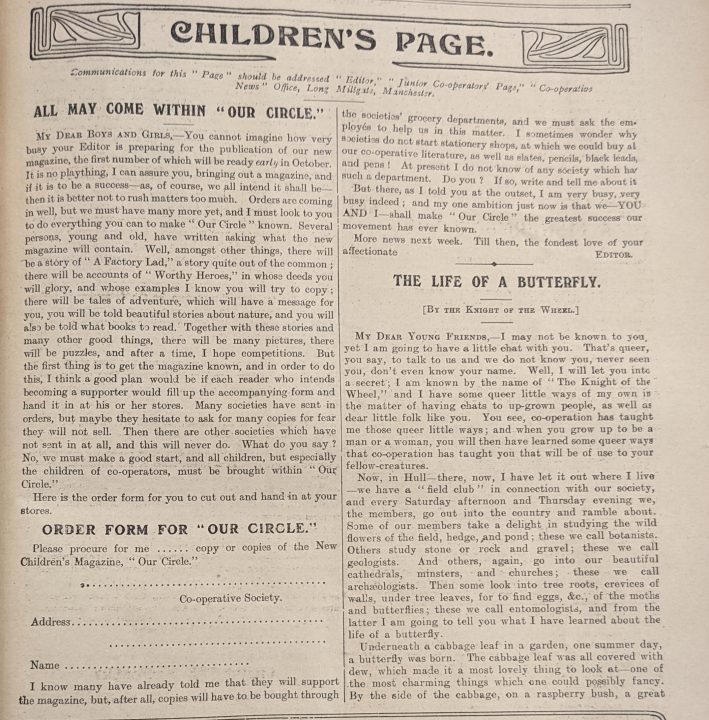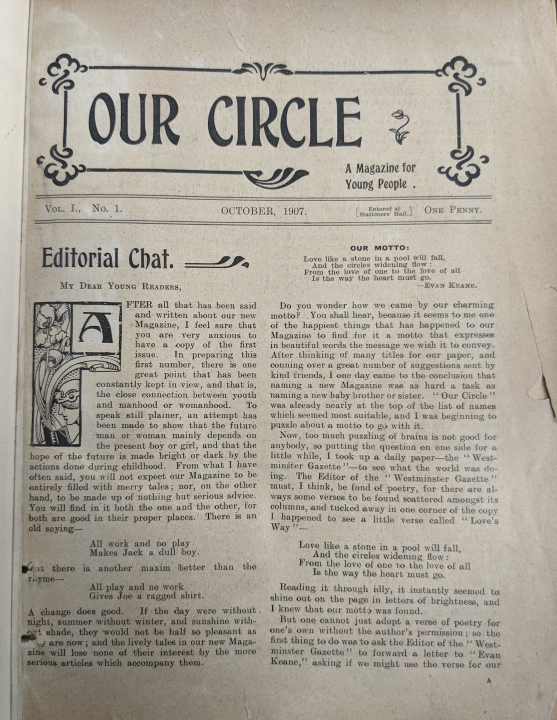Annie Bamford Tomlinson (1870-1833) is well known as a co-operator, campaigner and daring journalist. Her father (Samuel Bamford) was an early editor and secretary of the Co-operative News and established a ‘Woman’s Corner’ (later renamed ‘Women’s Pages’) in the publication in 1883. This was first edited by Alice Acland, and later by Bamford Tomlinson, who was also involved in the development of the Women’s Co-operative Guild and the ‘Women’s Outlook’ magazine.
But as well as catering for women’s interests, Bamford Tomlinson was passionate about sharing co-operation with children and young people, and edited a long-running Children’s Page in Co-operative News, which followed immediately after the Women’s Pages.
The Children’s Page was set out as a letter from the Children’s Editor – each one beginning “My dear girls and boys…” – that included updates from the movement that were relevant to children, anecdotes, poems and responses to letters sent into the Children’s Circle, the informal group who read, wrote and into the page.
In July 1907, Bamford Tomlinson wrote on this page: “As your editor, I have tried to make The Children’s page worth the attention of all the children of the movement, but lately I have found it impossible to deal with the great multitude of letters and information the ‘Circle’ members send me – that is, in the space that is allowed us. And it is because of this lack of space that some of our ‘Circle’ members have suggested that we should have a magazine of our own….”
Readers are asked direct questions and are encouraged to get involved: “There are a few magazines published for young people, each of which may have something good in it, but are they exactly suited to the tastes of young co-operators? In my opinion, many are entertaining, but not serious; others are serious but not interesting or entertaining, and I think that young people require a mixture of grave and gay to edify them. If it is decided to start a ‘magazine’ for our young people, what I want to know is: How many young co-operators will support it, say at 1d. per month? … I want all young co-operators to become interested and let the editor of the Children’s Page know what they think of the idea…”

The purpose of the magazine was to encourage the values of co-operation, both in its readers and children more widely. In the same article, Bamford Tomlinson writes: “You and I cannot be happy with how many little children are born in misery and live in dark, cold rooms in narrow alleys where the sun never shines. No; it is unjust that such conditions of life should exist, and we – we young people who belong to the glorious movement of co-operation – must try and prevent this system of injustice. We must not cure, we must prevent; and when you have learnt this, you will understand what is meant by co-operation. You will wish to know more about what are called the great social questions of the day; in other words, you will want more enlightenment. We must not think of pleasure for ourselves when we talk of this new magazine of ours–if we do then we are selfish– we must think of those children about whom I have just been speaking, those who are oppressed, and then, only then, ought you to enjoy the idea of having a ‘magazine’ because the pleasure would be pleasure for all.”
Bamford Tomlinson approached the Co-operative Press Board with the proposal, and on 14 August 1907 the board passed resolutions that the title of the magazine be “Our Circle”, and that the title page would be designed by Mr Walter Grave for £10. Co-operative retail societies were approached for support, and readers of the children’s page were encouraged to hand in coupons (printed in Co-operative News) to their local co-op store to indicate interest.

Our Circle also had support from the Co-operative Union (later Co-operatives UK). “Dear Mr Bamford,” wrote the Central Educational Committee of the Union on 16 August. “[The Committee] are very pleased to see that an attempt is being made to bring out a monthly magazine for junior co-operators. They think this is a step in the right direction and the ‘News’ are to be commended for taking such a forward move. They sincerely hope your efforts will be crowned with success, and they will do all they possibly can to make such a magazine known, especially amongst the juniors attending the classes, organised under their auspices. Last session over 7,000 juveniles were enrolled in the various classes, and the committee see in the proposed magazine, and the study of the little book, Our Story, a splendid means of spreading amongst the children of co-operators the ideals, aims and objectives of the co-operative movement.”
Over the following weeks, the Children’s Page in Co-op News gave updates on the progress of the magazine. “My dear boys and girls – You cannot imagine how very busy your editor is preparing for the publication of our new magazine, the first number of which will be ready early in October,” Bamford Tomlinson wrote on 7 September.
“Several persons, young and old, have written asking what the magazine will contain. Well, amongst other things, there will be a story of “A Factory Lad’, a story quite out of the common; there will be accounts of worthy heroes in whose deeds you will glory, and whose examples I know you will try to copy; there will be tales of adventure, which will have a message for you; you will be told beautiful stories about nature; and you will also be told what books to read. Together with these stories and many other good things, there will be many pictures, there will be puzzles, and after a time, I hope competitions.”
The first edition of Our Circle was published on 12 October 1907, and as the publication grew, it included all of the above and more, such as writing and drawing competitions, practical tips on outdoor activities and lessons in Esperanto, to name a few – all with the aim of sharing ideas of co-operation through values-led writing and participation.

Our Circle was by no means the only publication for children; in 1927 Co-operative Press launched the Sunshine Annual, which combined entertainment with education about the co-operative movement and its history through stories aimed at younger children. This learning through play was also taken on by the Co-operative Union itself, which worked with Co-operative Press to print a series of “Co-operative Plays for Children” with titles such as “A Forest of Holyoakes”, “The Dawn” and “Clouds and Sunshine”.
Our Circle continued for over 50 years, but the post-war period saw huge changes in the UK co-op movement: the number of consumer societies significantly reduced following mergers, and a drop in surpluses meant budget cuts. This, along with changing tastes and a falling circulation meant that in 1960 the Co-operative Press board resolved that “Our Circle” be discontinued and a children’s feature be incorporated into Women’s Outlook – which itself lasted until 1967.
“I shall remember you all with affection,” the final editor’s note read.
“Goodbye to you all and thank you for your loyalty to a magazine which I hope you will remember with pride.”
Previous editions of Our Cicle, Co-operative News and many other historic publications and artefacts associated with the co-oerative movement (including board minutes) can be viewed at the Co-operative Archive, part of the Co-operative Heritage Trust.

